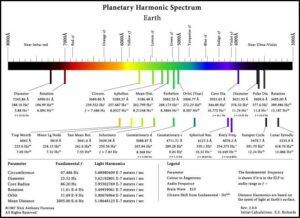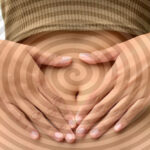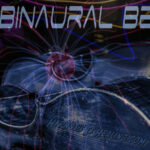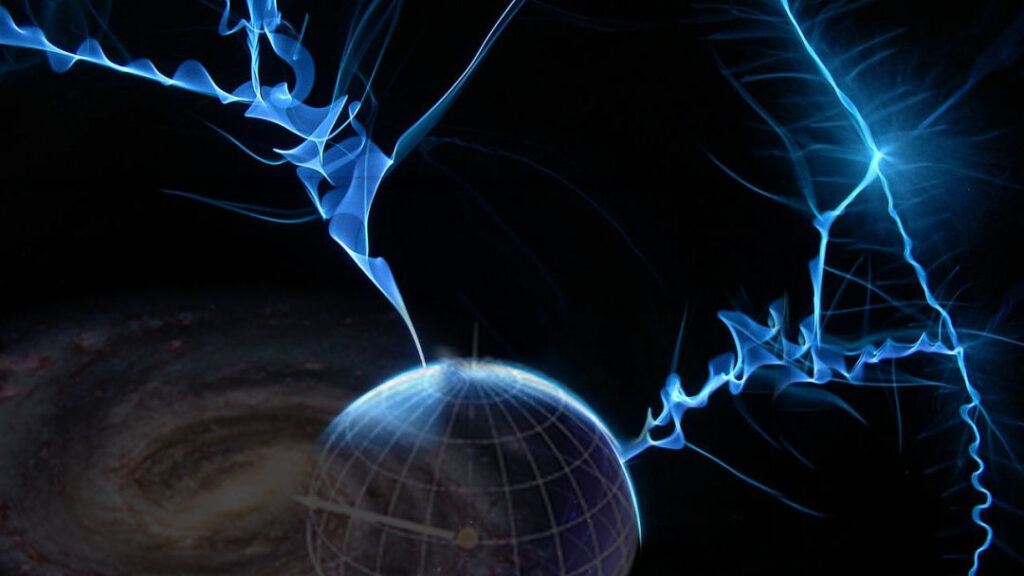
In this article, we will discuss the Schumann Resonance and Solfeggio Frequencies and how they impact our environment. The Schumann Resonance (SR) is a set of spectrum peaks in the extremely low frequency (ELF) portion of the Earth’s electromagnetic field spectrum. Schumann Resonance is a set of global electromagnetic resonances, excited by lightning discharges in the cavity formed by the Earth’s surface and the ionosphere.
Schumann Resonance What Is It?
This global electromagnetic resonance phenomenon is named after physicist Winfried Otto Schumann who predicted it mathematically in 1952. Schumann Resonance occurs because the space between the surface of the Earth and the conductive ionosphere acts as a closed waveguide. 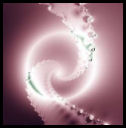 The limited dimensions of the Earth cause this waveguide to act as a resonant cavity for electromagnetic waves in the ELF band. The cavity is naturally excited by electric currents in lightning. Schumann Resonance is the principal background in the electromagnetic spectrum beginning at 3 Hz and extending to 60 Hz and appearing as distinct peaks at extremely low frequencies (ELF) around 7.83 (fundamental), 14.3, 20.8, 27.3, and 33.8 Hz.
The limited dimensions of the Earth cause this waveguide to act as a resonant cavity for electromagnetic waves in the ELF band. The cavity is naturally excited by electric currents in lightning. Schumann Resonance is the principal background in the electromagnetic spectrum beginning at 3 Hz and extending to 60 Hz and appearing as distinct peaks at extremely low frequencies (ELF) around 7.83 (fundamental), 14.3, 20.8, 27.3, and 33.8 Hz.
In the normal mode descriptions of Schumann Resonance, the fundamental mode is a standing wave in the Earth-ionosphere cavity with a wavelength equal to the circumference of the Earth. This lowest-frequency (and highest-intensity) mode of the Schumann resonance occurs at a frequency of approximately 7.83 Hz, but this frequency can vary slightly from a variety of factors, such as solar-induced perturbations to the ionosphere, which comprises the upper wall of the closed cavity. The higher resonance modes are spaced at approximately 6.5 Hz intervals, a characteristic attributed to the atmosphere’s spherical geometry. The peaks exhibit a spectral width of approximately 20% on account of the damping of the respective modes in the dissipative cavity. The eighth overtone lies at approximately 59.9 Hz.
Observations of Schumann Resonance have been used to track global lightning activity. Owing to the connection between lightning activity and the Earth’s climate it has been suggested that they may also be used to monitor global temperature variations and variations of water vapor in the upper troposphere. It has been speculated that extraterrestrial lightning (on other planets) may also be detected and studied by means of their Schumann resonance signatures. Schumann Resonance has been used to study the lower ionosphere on Earth and it has been suggested as one way to explore the lower ionosphere on celestial bodies. Effects on Schumann Resonance have been reported following geomagnetic and ionospheric disturbances. More recently, discrete Schumann resonance excitations have been linked to transient luminous events – sprites, elves, jets, and other upper-atmospheric lightning. A new field of interest using Schumann Resonance is related to short-term earthquake prediction.
What Is Schumann Resonance Today?
The resonant frequency of the Schumann resonance is 7.83 Hz, which is very close to the alpha brainwave frequency (8-12 Hz). This similarity has led to speculation that the Schumann resonance may be involved in human consciousness.
Schumann History
The first documented observations of global electromagnetic resonance were made by Nikola Tesla at his Colorado Springs laboratory in 1899. This observation led to certain peculiar conclusions about the electrical properties of the earth, which made the basis for his idea for wireless energy transmission.
Tesla researched ways to transmit power and energy wirelessly over long distances (via transverse waves, to a lesser extent, and, more readily, longitudinal waves). He transmitted extremely low frequencies through the ground as well as between the Earth’s surface and the Kennelly-Heaviside layer. He received patents on wireless transceivers that developed standing waves by this method. Making mathematical calculations based on his experiments, Tesla discovered that the resonant frequency of the Earth was approximately 8 hertz (Hz). In the 1950s, researchers confirmed that the resonant frequency of the Earth’s ionospheric cavity was in this range (later named the Schumann resonance).
The first suggestion that an ionosphere existed, capable of trapping electromagnetic waves, was made by Heaviside and Kennelly in 1902. It took another twenty years before Edward Appleton and Barnett 1925, were able to prove experimentally the existence of the ionosphere.
Although some of the most important mathematical tools for dealing with spherical waveguides were developed by G. N. Watson in 1918, it was Winfried Otto Schumann who first studied the theoretical aspects of the global resonances of the earth-ionosphere waveguide system, known today as the Schumann Resonance. From 1952-to 1954 Schumann, together with H. L. König, attempted to measure the resonant frequencies. However, it was not until measurements made by Balser and Wagner in 1960-1963 that adequate analysis techniques were available to extract the resonance information from the background noise. Since then there has been an increasing interest in Schumann Resonance in a wide variety of fields.
Does the Schumann Resonance Affect Humans?
The Schumann resonance is a naturally occurring electromagnetic field that surrounds the Earth. This field oscillates at a very low frequency and is thought to be caused by lightning strikes in the upper atmosphere. There is some evidence to suggest that this field can affect human health and well-being. For example, it has been shown that exposure to the Schumann resonance can improve sleep quality and reduce stress levels. Additionally, there is evidence that suggests that the Schumann resonance may be beneficial for those suffering from conditions like Alzheimer’s disease and dementia.
While more research is needed to confirm these claims, the Schumann resonance may offer some benefits for human health. Therefore, it is important to consider this when making decisions about electromagnetic field exposure.
At what Frequency Does the Earth Vibrate?
The Earth vibrates at a frequency of 7.83 Hz.
Does the Schumann Resonance Affect Your Blood Pressure?
Yes, the Schumann resonance can affect your blood pressure. The reason for this is that the Schumann resonance is a very low-frequency electromagnetic field that surrounds the earth. This field has been shown to have an effect on human physiology, and blood pressure is one of the things that can be affected. There are a few studies that have looked at this specifically, and they have found that exposure to the Schumann resonance can lower blood pressure. One study found that people who were exposed to the Schumann resonance for one hour had a decrease in blood pressure of about 5%. Another study found that exposure to the Schumann resonance for two hours resulted in a decrease in blood pressure of about 10%. So, it is clear that the Schumann resonance can have an effect on blood pressure, and it is something that you should be aware of if you have high blood pressure. If you are looking for ways to lower your blood pressure, you may want to consider exposure to the Schumann resonance.
Solfeggio Frequency
 The Solfeggio frequencies are a set of nine tones that were used in Gregorian chants. They are said to have a profound effect on the human body and can be used to promote healing and well-being.
The Solfeggio frequencies are a set of nine tones that were used in Gregorian chants. They are said to have a profound effect on the human body and can be used to promote healing and well-being.
The Solfeggio frequencies were first used in the 9th century. The frequencies were rediscovered in the 1970s, and have since been used in a variety of settings, including music therapy and sound healing.
The Solfeggio frequencies are believed to have a range of health benefits, including reducing stress and anxiety, improving sleep quality, and boosting the immune system. There is also some evidence that these frequencies can help to alleviate pain.
What are the Nine Solfeggio Frequencies?
- 174 Hz – Reduce physical and energetic suffering. Gather a feeling of security and safety
- 285 Hz – Allow the Body’s Regeneration; Receive a Feeling of Well-Being and Optimism
- 396 Hz – Increase feelings of safety, groundedness, and connection. Reduce Fear, Guilt, & Shame. Boost Feelings of Being Protected, Grounded and Connected
- 417 Hz – Create Space and Momentum for Positive Change: Reconnect to the Divine
- 528 Hz – Forgive and Release Fear. Make Room for Miracles and Unconditional Love
- 639 Hz – Boost Your Self-Esteem, Improve Your Relationships, and Create Harmony in Your Interpersonal Communications
- 741 Hz – Powerful, Simple & Creative Personal Expression
- 852 Hz – Connecting to the Higher Self’s Wisdom and Intuition
- 963 Hz – Discover your inner divinity. Breakthrough your sense of oneness and heal from an eternal perspective.
Ancient Solfeggio frequencies are paired with deeply relaxing meditations, then followed by affirmations developed and spoken by HypnosisIsHealing.com to boost the healing, purifying, and energy-expanding attributes of each frequency’s specific effects.
Can I listen to Solfeggio Frequencies while Sleeping?
There is no right or wrong answer to this question. Solfeggio frequencies can be used in a number of different ways, and it is ultimately up to the individual to decide how they would like to use them. Some people find that listening to Solfeggio frequencies while sleeping helps them to relax and get a good night’s sleep, while others find that it helps to reduce stress and anxiety levels. There is no scientific evidence to suggest that Solfeggio frequencies have any specific effect on sleep, but many people find that they are helpful nonetheless. Ultimately, it is up to the individual to experiment with different methods of using Solfeggio frequencies and see what works best for them.
How Do Solfeggio Frequencies Heal?
There is some scientific evidence that suggests that these frequencies can indeed have positive effects on the human body. The solfeggio frequencies help relax the muscles and relieve tension or pain. The solfeggio frequencies at 285 Hz are connected to feelings of safety, vitality, and survival. It is a frequency associated with Muladhara Chakra, which is the body’s most fundamental and basic energy source located near the spine’s base.
For further clarification, there are two studies that found exposure to Solfeggio frequencies can help to reduce stress and anxiety levels (1); while another found that Solfeggio frequencies can help to improve sleep quality (2) – See References Below.
How Long Should You Listen to Solfeggio Frequencies?
15 minutes of listening once a week for four weeks is sufficient to experience the therapeutic effects of solfeggio frequencies. I’d then advise you to sit down with yourself and journal how you’re feeling, as well as whether there are any changes from how you felt a month ago.
| Bibliography |
| 1. Chakra balancing with Solfeggio Frequencies – A brief review. (n.d.). Retrieved from https://www.ncbi.nlm.nih.gov/pmc/articles/PMC4447314/ |
| 2. Solfeggio Frequencies for Sleep Improvement: A Preliminary Study. (2018, August 28). Retrieved from https://www.ncbi.nlm.nih.gov/pmc/articles/PMC6141873/ |
